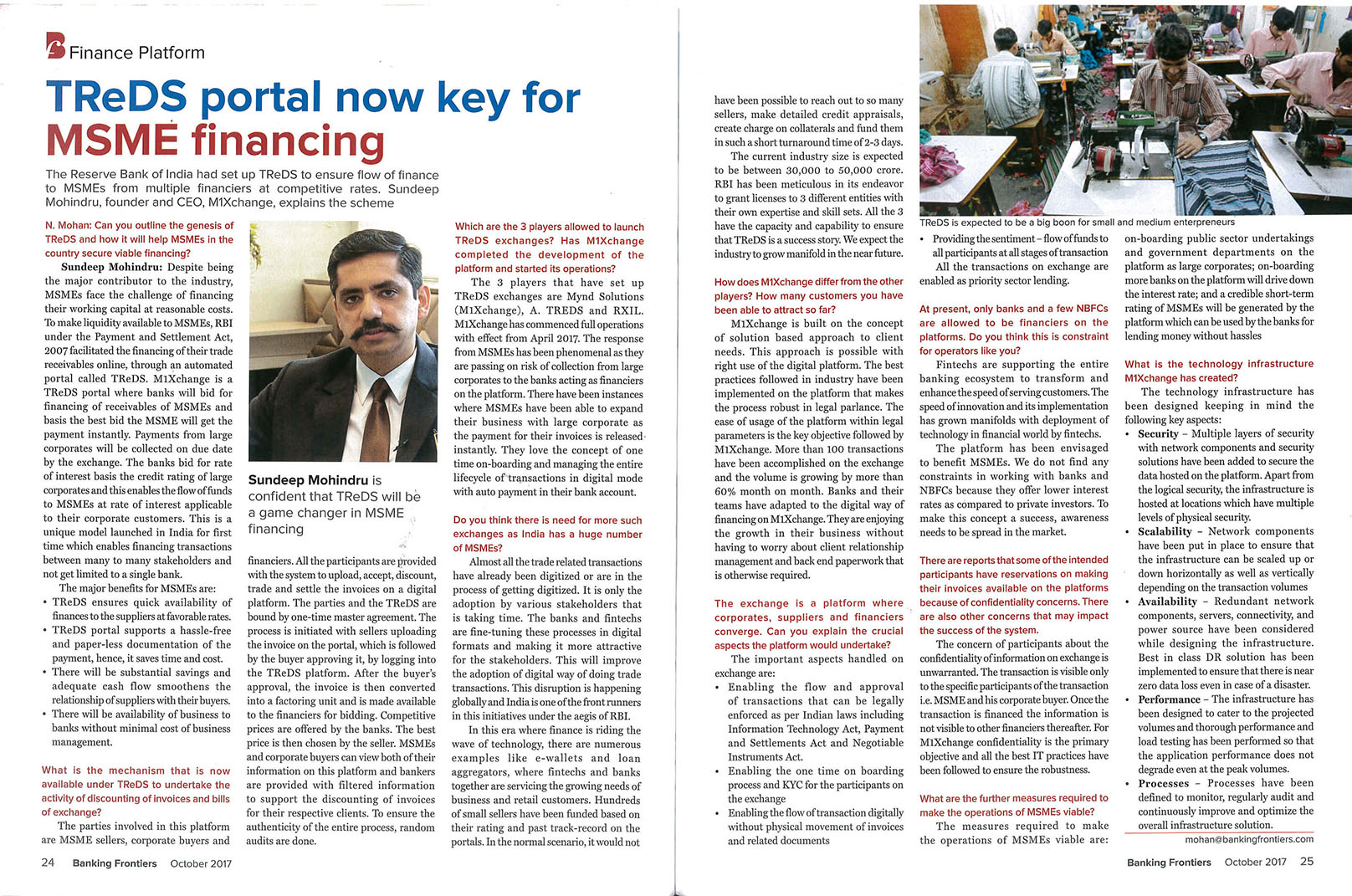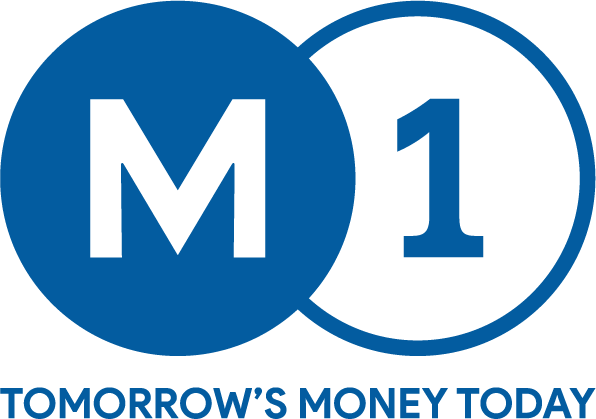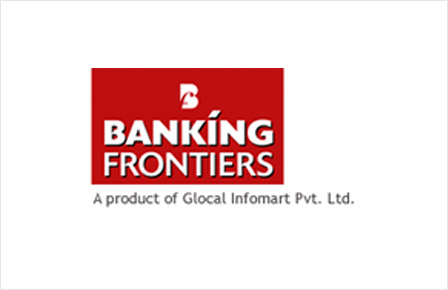Publication: Banking Frontiers
Journalist: N Mohan
Topic: TReDS
N. Mohan: Can you outline the genesis of TReDS and how it will help MSMEs in the country secure viable financing? What according to you will be the major benefits that the system will bring in for MSMEs?
Sundeep Mohindru: Despite being the major contributor to the industry, MSMEs face the challenge of financing their working capital at reasonable cost. To make liquidity available to MSMEs, RBI under the payment and settlement Act, 2007 facilitated the financing of their trade receivables online, through an automated portal called TReDS.
M1Xchange, a TReDS portal is a market place where banks will bid for financing of receivables of MSME and basis the best bid the MSME will get the payment instantly. Payment from the large corporate will be collected on due date by the exchange. The banks bid for rate of interest basis the credit rating of large corporates and this enables the flow of funds to MSME at rate of interest applicable to their corporate customers. This is a unique model launched in India for first time which enables financing transactions between many to many stakeholders and not get limited to a single bank.
Mynd Solutions launched M1Xchange on April 7, 2017 and has on-boarded many large Corporates, their vendors (MSME), banks and NBFC’s to do the transactions. The manual bill discounting market size currently stands at Rs 30,000 crore annually. With the online system coming in place, it is only expected to grow manifold in the years to come.
The major benefits to MSMEs suppliers are:
- TReDs ensure quick availability of finances to the suppliers at favourable rates
- TReDS portal supports a hassle-free and paper-less documentation of the payment, hence, it saves time and cost.
- Substantial savings and adequate cash flow smoothens the relationship of suppliers with their buyers
- Availability of business to banks without minimal cost of business management
N. Mohan: What is the mechanism that is now available under TReDS to undertake the activity of discounting of invoices and bills of exchange?
Sundeep Mohindru: The parties involved in this platform are MSME sellers, corporate buyers and financiers. All the participants are provided with the system to upload, accept, discount, trade and settle the invoices on a digital platform. The parties and the TReDS are bound by one-time agreement which is called the Master agreement. The process is initiated with sellers uploading the invoice on the portal, which is followed by the buyer approving it, by logging into TReDS platform. After the buyer’s approval, the invoice is then converted into a factoring unit and is made available to the financiers for bidding. Competitive prices are offered by the banks. The best price is then chosen by the seller. MSMEs and corporate buyers can view both of their information on this platform and bankers are provided with filtered information to support the discounting of invoices for respective client. To ensure the authenticity of the entire process, random audits are done.
N. Mohan: Which are the 3 players allowed by RBI to launch TReDS exchanges? Has M1Xchange completed the development of the platform and started its operations on a full scale? What has been the response from MSMEs?
Sundeep Mohindru: Mynd Solutions (M1Xchange), A. TREDS and RXIL are three players that have set up TREDS exchange. M1Xchange has commenced full operations with effect from April 2017. The response from MSME’s has been phenomenal as they are passing on risk of collection from large corporates to the banks acting as financier on the platform. There have been instances where MSME’s have been able to expand their business with large corporate as the payment for their invoices is released instantly. They love the concept of one time on boarding and managing the entire lifecycle of transactions in digital mode with auto payment in their bank account. They are the happiest customer in the entire ecosystem. The MSME’s are approaching their corporate customers and are requesting them to join the M1Xchange.
N. Mohan: Do you think there is need for more such exchanges as India has a huge number of MSMEs?
Sundeep Mohindru: Almost all the trade related transactions have already been digitised or are in the process of getting digitised. It is only the adoption by various stakeholders that is taking time. The banks and fintechs are fine tuning these processes in digital formats and making it more attractive for the stake holders. This will improve the adoption of digital way of doing trade transactions. This disruption is happening globally and India is one of the front runners in this initiatives under the aegis of RBI.
In this era where finance is riding the wave of technology, there are numerous examples in our daily life ranging from e-wallets to loan aggregators vide online portals, where Fintechs and banks together are servicing the growing needs of business and retail customers. Hundreds of small sellers have been funded based on their rating and past track-record on the portals. In the normal scenario it would not have been possible to reach out to so many sellers, make detailed credit appraisals, create charge on collaterals and fund them in such a short turnaround time of 2-3 days.
The current industry size is expected to be between 30,000 to 50,000 crores. RBI has been meticulous in its endeavour to grant licenses to three different entities with their own expertise and skill-sets. All three have the capacity and capability to ensure that TReDS is a success story. We thus expect the industry to grow manifold in the near future.
N. Mohan: How does M1Xchange differ from the other players? How many customers you have been able to attract so far? What is the volume of business you could accomplish? Which are the manor customers?
Sundeep Mohindru: M1Xchange is built on the concept of solution based approach to client needs. This approach is possible with right use of digital platform. The best practices followed in industry have been implemented on the platform that makes the process robust in legal parlance. The ease of usage of platform within legal parameters is the key objective followed on M1Xchange.
More than 100 transactions have been accomplished on exchange and the volume is growing by more than 60% month on month. Banks and their teams have adapted to the digital way of financing on M1Xchange. They are enjoying the growth in their business without having to worry about Client relationship management and back end paperwork.
N. Mohan: The exchange is a platform where corporates, suppliers and financiers converge. Can you explain the crucial aspects the platform would undertake?
Sundeep Mohindru: The important aspects handled on exchange are:
- Enabling the flow and approval of transactions that can be legally enforced as per Indian laws including Information Technology Act, Payment and Settlements Act and Negotiable Instruments Act.
- Enabling the one time on boarding process and KYC for the participants on the exchange
- Enable the flow of transaction digitally without physical movement of invoices and related documents.
- The exchange provides the sentiment – flow of funds to all participants at all stages of transaction.
- All the transactions on exchange are enabled as PSL (Priority sector lending) for the banks
N. Mohan: At present only banks and a few NBFCs are allowed to be financiers on the platforms. Do you think this is constraint for operators like you? What according to you are the measures that are needed to make the concept a success?
Sundeep Mohindru: Fintechs are supporting the entire banking ecosystem to transform and enhance the speed of serving customers. The speed of innovation and its implementation has grown manifolds with deployment of technology in financial world by Fintechs. The platform has been envisaged to benefit MSMEs. We do not find any constraints in working with banks and NBFCs because they offer lower interest rates as compared to private investors. In order to make this concept a success, awareness needs to be spread in the market.
N. Mohan: There are reports that some of the intended participants have reservations on making their invoices available on the platforms because of confidentiality concerns. There are also other concerns that may impact the success of the system. Can you comment on these concerns?
Sundeep Mohindru: The concern of participants about the confidentiality of information on exchange is unwarranted. The transaction is visible only to the specific participants of the transaction i.e. MSME and his corporate buyer. Once the transaction is financed the information is not visible to other financiers thereafter. For M1Xchange confidentiality is the primary objective and all the best IT practices have been followed to ensure the robustness.
N. Mohan: What are the further measures required to make the operations of MSMEs viable?
Sundeep Mohindru: The measures required to make the operations of MSMEs viable are:
- On-boarding public-sector undertakings (PSUs) and government departments on the platform as large corporates
- On boarding more banks on the platform will drive down the interest rate.
- A credible short-term ratings of MSMEs will be generated by the platform which can be used by the banks for lending money without hassles
N. Mohan: What is the technology infrastructure M1Xchange has created?
Sundeep Mohindru: The technology infrastructure has been designed keeping in mind the following key aspects:
- Security – Multiple layers of security with network components and security solutions have been added to secure the data hosted on the platform. Apart from the logical security, the infrastructure is hosted at locations which have multiple levels of physical security.
- Scalability – Network components have been put in place to ensure that the infrastructure can be scaled up or down horizontally as well as vertically depending on the transaction volumes
- Availability – Redundant network components, servers, connectivity, and power source have been considered while designing the infrastructure. Best in class DR solution has been implemented to ensure that there is near zero data loss even in case of a disaster.
- Performance – The infrastructure has been designed to cater to the projected volumes and thorough performance and load testing has been performed so that the application performance does not degrade even at the peak volumes
- Processes – Processes have been defined to monitor, regularly audit and continuously improve and optimize the overall infrastructure solution.


